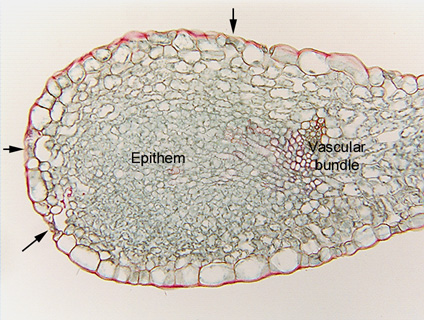 Fig.
9.3-10. Transverse section of leaf of Brassica
oleracea (this species has many varieties: broccoli, Brussels sprouts,
cabbage, cauliflower, kale and kohlrabi). The secretory structure in this leaf
is a hydathode, a gland that secretes water
(see page 157 in Plant Anatomy (Mauseth) for details of the physiology).
Hydathodes are supplied by a vascular bundle that ends just at the border of the
hydathode or actually within it (as here). The bulk of the glandular tissue is a
very open, aerenchymatous parenchyma with the special name of epithem. Often, there is a compact
boundary layer (called a sheath)
that separates the epithem from the rest of the leaf cells, but the hydathode
shown here lacks a sheath. Epithem cells absorb mineral nutrients out of the
xylem sap and transfer them to the leaf tissues, and excess water accumulates in
the intercellular spaces; as the water accumulates, pressure builds and forces
water out of wide stomata called water
pores (arrows). The process of secreting excess water is called guttation.
Fig.
9.3-10. Transverse section of leaf of Brassica
oleracea (this species has many varieties: broccoli, Brussels sprouts,
cabbage, cauliflower, kale and kohlrabi). The secretory structure in this leaf
is a hydathode, a gland that secretes water
(see page 157 in Plant Anatomy (Mauseth) for details of the physiology).
Hydathodes are supplied by a vascular bundle that ends just at the border of the
hydathode or actually within it (as here). The bulk of the glandular tissue is a
very open, aerenchymatous parenchyma with the special name of epithem. Often, there is a compact
boundary layer (called a sheath)
that separates the epithem from the rest of the leaf cells, but the hydathode
shown here lacks a sheath. Epithem cells absorb mineral nutrients out of the
xylem sap and transfer them to the leaf tissues, and excess water accumulates in
the intercellular spaces; as the water accumulates, pressure builds and forces
water out of wide stomata called water
pores (arrows). The process of secreting excess water is called guttation.